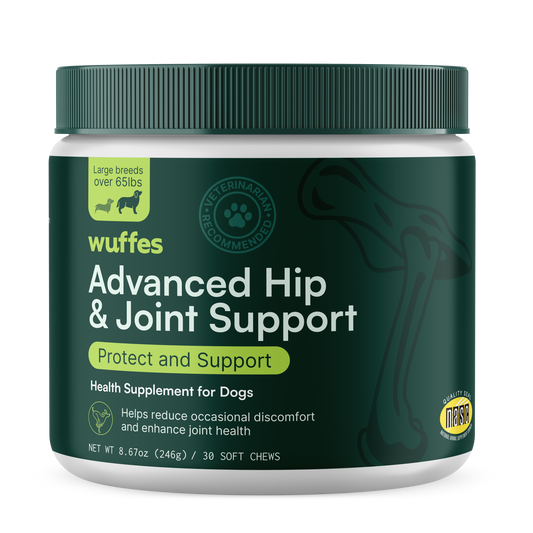The signs of mobility disorders in dogs often creep up gradually. Dogs age often more quickly than we realize. Some giant breed dogs (such as Great Danes) are already seniors when they are 5 years old. You may notice symptoms such as:
- Having trouble getting off the floor
- Not being able to go on long walks
- Difficulty jumping up onto objects or into the cart
- Trouble navigating stairs
Many senior dogs experience mobility challenges due to joint pain, spinal cord disease, or other underlying health conditions, all of which can impact their movement and overall comfort. The good news is that with early health screening and proactive care, you can help your dog stay active and improve their quality of life. The first step is identifying the root cause of their mobility issues. A proper diagnosis ensures that your dog gets the right treatment - whether it’s joint supplements, pain management, rehabilitation, or adjustments to their daily routine. Understanding what’s truly affecting their movement is key to keeping them happy, comfortable, and on the go.
Arthritis, Spinal Cord Disease, or Something Else? Why a Diagnosis Matters
There are multiple conditions that can affect mobility in senior dogs. Knowing whether your dog has arthritis, a spinal condition, or even cognitive decline will help you give them the right kind of support. Symptoms associated with mobility disorder are listed below.
Arthritis & Joint Pain:
- Trouble getting up from lying down, stiffness after resting
- Slower on walks but improves after warming up
- Limping or favoring a particular leg
Spinal Cord Disease (such as disc disease):
- Dragging paws, knuckling, or wobbliness when walking
- Crossing of legs or splaying of limbs (legs sliding outward, difficulty standing on slippery surfaces)
Dementia (Canine Cognitive Dysfunction) [1]:
- Anxiety, confusion, or hesitation around familiar places
- Getting “stuck” in corners, not responding to cues
- Restlessness, especially at night (pacing, whining, panting). This can be mistaken for arthritic pain
How your vet can help diagnose mobility issues
General Physical Exam & Senior Bloodwork
Your vet will start with a thorough physical exam and routine blood tests to rule out vision loss, systemic conditions, or tick-borne diseases that could be causing your dog to slow down.
Orthopedic & Neurological Exams
A hands-on evaluation will help determine whether the issue stems from joint disease (arthritis) or a spinal cord condition affecting nerve function.
X-Rays
If arthritis is suspected, X-rays are used to confirm the diagnosis and assess the severity of joint changes
How you can help
Just like for us, exercise is essential to maintaining the physical and mental health of our pets. Regular activity keeps joints healthy, strengthens muscles, and helps maintain balance and coordination, all of which naturally decline with age and spinal cord disease. The degree of exercise appropriate for your dog depends on their condition. However, short, frequent walks are often better than one long walk for dogs with mobility disorders. A rehabilitation therapist can provide a specialized exercise plan tailored to your dog’s needs.
Recent data from the Dog Aging Project, showed that higher activity levels were correlated with lower CCD scores[2]
Mental & Sensory Enrichment
Puzzle toys, scent games, and new experiences help keep the brain sharp.
Supplements
Supplements help protect aging joints, reduce inflammation, and keep your dog moving comfortably
Joint & Mobility Health
- Omega-3 Fatty Acids (EPA & DHA) [3] - help reduce inflammation in arthritic joints and may provide neuroprotective benefits for dogs with dementia.
- Undenatured Type II Collagen (UC-II) [4] - works by modulating the immune system to reduce inflammation, which studies suggesting it helps maintain cartilage and improve comfort in dogs with arthritis.
- CBD [5] - derived from hemp, it targets the body’s own endocannabinoid receptors, providing pain relief and reducing inflammation.
- Glucosamine & Chondroitin [6] [7] - protect joint cartilage and delay progression of osteoarthritis.
- Methylsulfonylmethane (MSM) [8] - has anti-inflammatory properties.
- Hyaluronic Acid[9] - decreases joint pain and inflammation.
Brain Health
MCTs (medium-chain triglycerides), DHA, and antioxidants, support support brain function in aging dogs.[10]
Muscle Health
Myostatin inhibitors and ursolic acid supplements may help prevent muscle atrophy after orthopedic injury.[11][12][12]
Diet
- Weight loss - Obesity now affects an estimated 50% of pets. [14][15] Not only does obesity increase mechanical load of the joints, but it also contributes to inflammation in all major organ systems, including joints. [14]
- Protein - Older dogs naturally lose muscle mass with age, which can exacerbate instability and lead to poorer overall health and frailty [16]. For this reason, it is important to support muscle mass in dogs by increasing protein in their diet. [17]
Modifying the home environment
- Traction Flooring - Add rugs or traction mats to prevent slips, especially for dogs showing splaying or limb weakness.
- Accessibility - Ramps and stairs help reduce joint stress and prevent falls.
- Food & Water Bowls - Elevating dishes to elbow height can make them easier to reach and reduce neck strain.
- For Dogs with Dementia - Keeping a nightlight on and keeping the environment consistent can help reduce anxiety and confusion after dark.
Osteochondrosis (‘Osteochondritis dissecans’)
Osteochondrosis affects young, large dogs that grow rapidly. This condition interrupts the normal formation of cartilage and bone, leading to abnormal or detached joint cartilage.[5] This condition can lead to joint inflammation and osteoarthritis.
Symptoms include joint stiffness, lameness, and swelling within the joint (especially the shoulder, elbow, knee or ankle).[5] Diagnosis can be made through x-rays, CT or arthroscopy. Early intervention is crucial, which may include medical management or arthroscopic removal of the abnormal or detached cartilage.[5] Even if arthroscopic surgery is performed, osteoarthritis is expected to progress within the joint, requiring lifelong medical management (see above).
Is there anything else pet parents can do?
Dogs with mobility disorders may benefit from:
- Pain medications
- Joint injections (for arthritis)
- A prescription exercise program
- Acupuncture
- Laser or shockwave therapy
If your dog is struggling with mobility, talk to your veterinarian first to determine the best treatment plan. For more complex or advanced cases, your vet may recommend a consultation with a board-certified specialist in canine veterinary sports medicine and rehabilitation (DACVSMR). These specialists have advanced training in managing orthopedic, neurological, and mobility disorders and can offer cutting-edge therapies tailored to your dog's specific needs.
Conclusion: A Comprehensive Approach to Senior Dog Mobility
Many aging dogs can have one or more conditions that affect mobility such as arthritis, spinal cord disease, and cognitive decline - understanding what’s really going on helps you support them better.
Be proactive! If your dog is slowing down, stumbling, or showing signs of confusion, talk to your vet to create the best care plan for them.
References
- Landsberg GM, Nichol J, Araujo JA. Cognitive Dysfunction Syndrome A Disease of Canine and Feline Brain Aging. Vet Clin North Am: Small Anim Pr. 2012;42(4):749-768. doi:10.1016/j.cvsm.2012.04.003
- Yarborough S, Fitzpatrick A, Schwartz SM, et al. Evaluation of cognitive function in the Dog Aging Project: associations with baseline canine characteristics. Sci Rep. 2022;12(1):13316. doi:10.1038/s41598-022-15837-9
- Barbeau-Grégoire M, Otis C, Cournoyer A, Moreau M, Lussier B, Troncy E. A 2022 Systematic Review and Meta-Analysis of Enriched Therapeutic Diets and Nutraceuticals in Canine and Feline Osteoarthritis. Int J Mol Sci. 2022;23(18):10384. doi:10.3390/ijms231810384
- Gencoglu H, Orhan C, Sahin E, Sahin K. Undenatured Type II Collagen (UC-II) in Joint Health and Disease: A Review on the Current Knowledge of Companion Animals. Animals. 2020;10(4):697. doi:10.3390/ani10040697
- Alvarenga IC, Panickar KS, Hess H, McGrath S. Scientific Validation of Cannabidiol for Management of Dog and Cat Diseases. Annu Rev Anim Biosci. 2023;11(1):227-246. doi:10.1146/annurev-animal-081122-070236
- McCarthy G, O’Donovan J, Jones B, McAllister H, Seed M, Mooney C. Randomised double-blind, positive-controlled trial to assess the efficacy of glucosamine/chondroitin sulfate for the treatment of dogs with osteoarthritis. Vet J. 2007;174(1):54-61. doi:10.1016/j.tvjl.2006.02.015
- Gallagher B, Tjoumakaris FP, Harwood MI, Good RP, Ciccotti MG, Freedman KB. Chondroprotection and the Prevention of Osteoarthritis Progression of the Knee. Am J Sports Med. 2015;43(3):734-744. doi:10.1177/0363546514533777
- Ahn H, Kim J, Lee MJ, Kim YJ, Cho YW, Lee GS. Methylsulfonylmethane inhibits NLRP3 inflammasome activation. Cytokine. 2015;71(2):223-231. doi:10.1016/j.cyto.2014.11.001
- Oe M, Tashiro T, Yoshida H, et al. Oral hyaluronan relieves knee pain: a review. Nutr J. 2016;15(1):11. doi:10.1186/s12937-016-0128-2
- Dewey CW, Davies ES, Xie H, Wakshlag JJ. Canine Cognitive Dysfunction: Pathophysiology, Diagnosis, and Treatment. Veterinary Clinics: Small Animal Practice. 2019;49(3):477-499. doi:10.1016/j.cvsm.2019.01.013
- White DA, Harkin KR, Roush JK, Renberg WC, Biller D. Fortetropin inhibits disuse muscle atrophy in dogs after tibial plateau leveling osteotomy. PLoS ONE. 2020;15(4):e0231306. doi:10.1371/journal.pone.0231306
- Ebert SM, Dyle MC, Bullard SA, et al. Identification and Small Molecule Inhibition of an Activating Transcription Factor 4 (ATF4)-dependent Pathway to Age-related Skeletal Muscle Weakness and Atrophy*. J Biol Chem. 2015;290(42):25497-25511. doi:10.1074/jbc.m115.681445
- Ebert SM, Nicolas CS, Schreiber P, et al. Ursolic Acid Induces Beneficial Changes in Skeletal Muscle mRNA Expression and Increases Exercise Participation and Performance in Dogs with Age-Related Muscle Atrophy. Animals. 2024;14(2):186. doi:10.3390/ani14020186
- Marchi PH, Vendramini THA, Perini MP, et al. Obesity, inflammation, and cancer in dogs: Review and perspectives. Front Vet Sci. 2022;9:1004122. doi:10.3389/fvets.2022.1004122
- Sapowicz SA, Linder DE, Freeman LM. Body Condition Scores and Evaluation of Feeding Habits of Dogs and Cats at a Low Cost Veterinary Clinic and a General Practice. Sci World J. 2016;2016(1):1901679. doi:10.1155/2016/1901679
- Russell KJ, Mondino A, Fefer G, et al. Establishing a clinically applicable frailty phenotype screening tool for aging dogs. Front Vet Sci. 2024;11:1335463. doi:10.3389/fvets.2024.1335463
- Laflamme D. 61 Life Stage Feeding: Is There Path Forward for Senior/Geriatric Nutrient recommendations? J Anim Sci. 2023;101(Supplement_3):113-114. doi:10.1093/jas/skad281.138
Dr. Jennifer Repac, DVM DACVSMR












